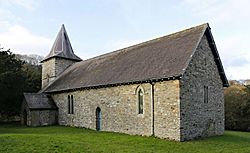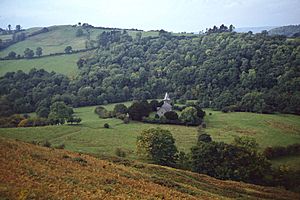Cefnllys facts for kids
Quick facts for kids Cefnllys
|
|
|---|---|
 St Michael's Church |
|
| OS grid reference | SO08936146 |
| Community |
|
| Principal area | |
| Ceremonial county | |
| Country | Wales |
| Sovereign state | United Kingdom |
| Postcode district | 15PD |
| Police | Dyfed-Powys |
| Fire | Mid and West Wales |
| Ambulance | Welsh |
| EU Parliament | Wales |
Cefnllys is an old, empty village, often called a ghost village. It was once a busy medieval town with a castle and its own special status as a borough. You can find it near Llandrindod Wells in Radnorshire (which is now part of Powys), Wales. The town was started in the 1200s by the powerful Mortimer family. They built it to help them control the land around Cefnllys Castle, which was very important to the town. Cefnllys was probably meant to be the main town for the area called Maelienydd. However, it didn't succeed and started to shrink in the 1300s. This happened because of serious sicknesses like the bubonic plague, being far away from other towns, and constant threats of war. Even though it became very small, Cefnllys kept its special borough status until the 1800s.
A Look Back: Cefnllys's Story
We don't know the exact year Cefnllys was founded. It might have been built around the same time as the first stone castle in the 1240s. But it's more likely it was built later, especially after King Edward I conquered Wales and built new English towns like Flint and Aberystwyth.
The town definitely existed by 1297. Records show it was given permission to hold a market. By 1304, it was a borough. At that time, it had 25 people living there, along with a church and a mill on the River Ithon. There was also a toll bridge, where people paid to cross, probably where a footbridge is today. A deer park, where deer were kept, was also mentioned in 1360. This park was likely north of the castle.
Having a manor (a large estate controlled by a lord) in a hilly area like Cefnllys was unusual. It shows how hard the Mortimer lords tried to set up their rule and make money from the Maelienydd region.
Challenges and Decline
The Welsh people in the area didn't like being ruled by English lords. In 1297, some unhappy locals went all the way to London to tell King Edward I their complaints. The king listened to them in the English Parliament. Later, the king sent letters to Edmund Mortimer, 2nd Baron Mortimer, telling him to bring back the traditional Welsh court. This made it harder for the castle's own court to be strong. The Mortimer lords only had real power in the area right around the town and castle.
Cefnllys didn't last long as a busy town. By 1332, only 20 people lived there. By 1383, it had shrunk even more, with only 10 special citizens called "burgesses." Its failure was probably due to several things.
- The Black Death: Terrible outbreaks of the plague hit Britain in 1349, 1361–62, and 1369. These killed many people.
- Isolation: The town was in a remote, hilly part of Mid Wales. This made it hard for businesses to succeed.
- Military Threats: The constant danger of war in the Welsh Marches (the borderlands between England and Wales) also made people leave.
Even after the medieval town faded away, Cefnllys kept its borough status. Over time, the borough grew to cover a fifth of the whole parish. From 1542 until 1885, it was a "contributory borough." This meant it joined with four other boroughs in Radnorshire to elect one person to represent them in the English and British Parliament. In 1742, a famous landscape painter named Thomas Jones was born in Cefnllys. By 1831, the borough had only 16 residents living in "three Farm Houses and one small Cottage."
Where Was the Town?
It's hard to say exactly where the town of Cefnllys was because there aren't many visible remains. Some people think the small population lived inside the area of Castle Bank. This is a large ridge where the Mortimer family built two castles in the 1200s. Those who believe this think the stone wall around the ridge was part of the town's defenses.
However, a more common idea is that the town was mainly around St Michael's Church. This area is on lower ground next to the river. Here, people would have had easy access to the mill and a nearby spring. Around the church, you can see old earthworks. These are like raised paths over wet ground, sunken roads leading to the old toll bridge, and places where medieval houses probably stood. There are also ridge and furrow patterns, which show where people used to farm in an open-field system.
Most of the old items found by archaeologists around the church are from the Tudor period (1485-1603) or later. The church building itself dates back to the 1200s, but we don't know exactly when it was first built. It was also heavily repaired in 1895.


